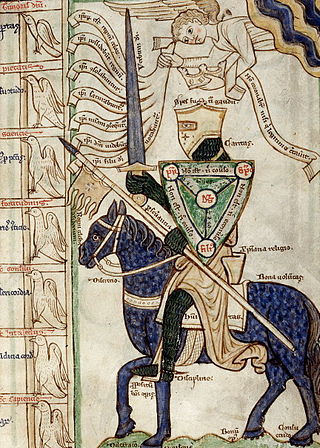
Paganism is a term first used in the fourth century by early Christians for people in the Roman Empire who practiced polytheism, or ethnic religions other than Judaism. In the time of the Roman Empire, individuals fell into the pagan class either because they were increasingly rural and provincial relative to the Christian population, or because they were not milites Christi. Alternative terms used in Christian texts were hellene, gentile, and heathen. Ritual sacrifice was an integral part of ancient Graeco-Roman religion and was regarded as an indication of whether a person was pagan or Christian. Paganism has broadly connoted the "religion of the peasantry".

In ancient Rome, the Latin word pagus was an administrative term designating a rural subdivision of a tribal territory, which included individual farms, villages, and strongholds serving as refuges, as well as an early medieval geographical term. From the reign of Diocletian onwards, the pagus referred to the smallest administrative unit of a province. These geographical units were used to describe territories in the Merovingian and Carolingian periods, without any political or administrative meaning.
WaleranII of Arlon, supposedly also called Udon of Limburg, was the count of Arlon from AD 1052 and, if he was the same person as Udon, also count of Limburg from 1065 and advocatus of the Abbey of Sint-Truiden. He was the younger son of Waleran I, Count of Arlon, and his wife Adelaide. His elder brother Fulk became Count of Arlon.

The genus Scarabaeus consists of a number of Afro-Eurasian dung beetle species, including the "sacred scarab beetle", Scarabaeus sacer and is the namesake of the tribe Scarabaeini, the family Scarabaeidae, the superfamily Scarabaeoidea and the infraorder Scarabaeiformia. These beetles feed exclusively on dung, which they accomplish by rolling a piece of dung some distance from where it was deposited, and burying it in order to feed on it underground. They also prepare food for their larvae by excavating an underground chamber, and filling it with balls that have eggs laid in them. The growing larva feeds upon the dung ball, pupates, and eventually emerges as an adult.

Plegadis is a bird genus in the family Threskiornithidae. The genus name derives from Ancient Greek plegados, "sickle", referring to the distinctive shape of the bill. Member species are found on every continent except Antarctica as well as a number of islands.

Uģis Prauliņš is a Latvian composer whose choral work Missa Rigensis was recorded by the Choir of Trinity College, Cambridge, the Riga Cathedral Boys Choir, Youth Choir BALSIS and has been performed in several locations around the world, amongst those Canada, France, England.
Gerandibis is an extinct genus of ibis known from fossil remains from early Miocene (Aquitanian) beds in France. It contains a single species, Gerandibis pagana, which was originally described by Milne-Edwards in 1868 as Ibis pagana. Richard Sharpe classified it in the genus Eudocimus, but Storrs L. Olson placed it in the genus Plegadis due to anatomical similarities closer to that genus. The ibises of the genus Plegadis have two natural foramina (holes) in the intertrochlear groove in the distal section of the tarsometatarsus, where as ibises of Eudocimus have one small foramen. P. paganus has two small holes akin to living species of Plegadis. The species was eventually made the type species of a separate genus Gerandibis by Vanesa L. De Pietri (2013).

The miles Christianus or miles Christi is a Christian allegory based on New Testament military metaphors, especially the Armor of God metaphor of military equipment standing for Christian virtues and on certain passages of the Old Testament from the Latin Vulgate. The plural of Latin miles (soldier) is milites or the collective militia.

Cyriopagopus is a genus of southeast Asian tarantulas found from Myanmar to the Philippines. As of March 2017, the genus includes species formerly placed in Haplopelma. It was first described by Eugène Louis Simon in 1887.
Rubus paganus is an uncommon North American species of brambles in the rose family. It grows in the Province of Québec in eastern Canada and also in the northeastern United States. Nowhere is it very common.
Jealousy is a 1953 Finnish drama film directed by Teuvo Tulio and starring Regina Linnanheimo, Eero Paganus and Assi Raine. It was a remake of Restless Blood (1946). The film was shot in parallel with the Swedish-language version Två kvinnor.
Tulcus paganus is a species of beetle in the family Cerambycidae. It was described by Francis Polkinghorne Pascoe in 1859. It is known from Bolivia, Brazil, Colombia and Peru.
Prosoplus paganus is a species of beetle in the family Cerambycidae. It was described by Francis Polkinghorne Pascoe in 1864. It is known from Moluccas and Papua New Guinea.
Euparius paganus is a species of fungus weevils in the family Anthribidae. It is found in North America.

Euparius is a genus of fungus weevils in the family Anthribidae. There are at least 6 described species in Euparius.
Tolmerus is a genus of robber flies in the family Asilidae. There are about 19 described species in Tolmerus.
Atheas is a genus of lace bugs in the family Tingidae. There are about 15 described species in Atheas.
Cyriopagopus paganus is a tarantula which was first described by Eugène Simon in 1887. They can be found in Thailand Vietnam, and Myanmar. They are burrowers, being found in this area, inside their burrows, waiting for prey.

Choerocoris is a genus of true bug in the family Scutelleridae. It contains five species:









